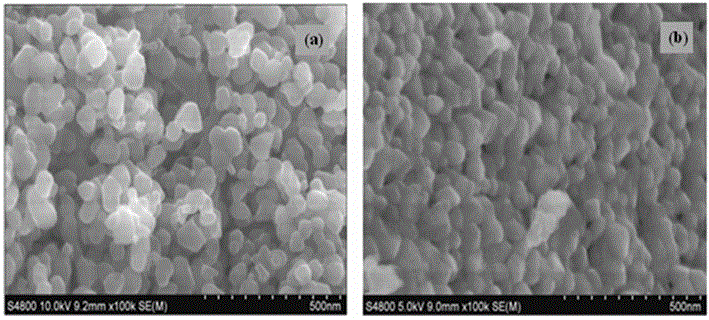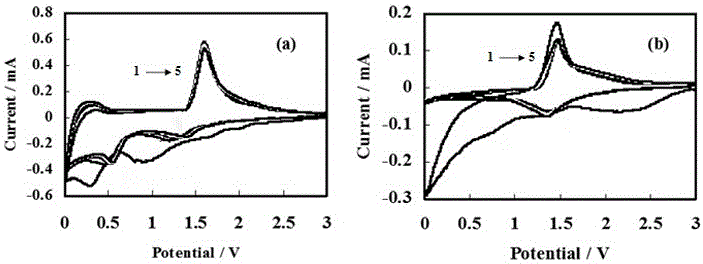Preparation method for copper-doped lithium zinc titanate nano particles and application thereof
A technology of lithium zinc titanate and nanoparticles, which is applied in nanotechnology, nanotechnology, nanotechnology for materials and surface science, etc., can solve problems such as poor lithium intercalation performance, and achieve low cost, easy operation, and improved intercalation. Poor Lithium Performance
- Summary
- Abstract
- Description
- Claims
- Application Information
AI Technical Summary
Problems solved by technology
Method used
Image
Examples
Embodiment 1
[0020] 1) Dissolve 280mg titanium isopropoxide in 570mg citric acid to obtain titanium citrate solution;
[0021] 2) Control the temperature of the titanium citrate solution to 60°C in a water bath, and then dissolve 25mg of lithium carbonate, 90mg of zinc nitrate hexahydrate and 3mg of copper nitrate trihydrate one by one;
[0022] 3) Add ethanol to the solution obtained in step 2) according to the weight ratio of ethanol to citric acid as 2:3, then raise the temperature of the solution to 80°C, and take it out after reaching the sol state;
[0023] 4) Put the sol obtained in step 3) into a crucible, heat-treat at 350°C for 1 hour, then grind it into a powder state with an agate mortar, put it in a muffle furnace, and calcinate it at 600°C for 3 hours to obtain copper-doped titanium Lithium zinc oxide nanoparticles.
Embodiment 2
[0025] 1) Dissolve 300mg titanium isopropoxide in 600mg citric acid to obtain titanium citrate solution;
[0026] 2) Control the temperature of the titanium citrate solution to 75°C in a water bath, and then dissolve 28mg of lithium carbonate, 110mg of zinc nitrate hexahydrate and 6mg of copper nitrate trihydrate one by one;
[0027] 3) Add ethanol to the solution obtained in step 2) according to the weight ratio of ethanol to citric acid as 2:3, then raise the temperature of the solution to 100°C, and take it out after reaching the sol state;
[0028] 4) Put the sol obtained in step 3) into a crucible, heat-treat at 500°C for 1 hour, then grind it into a powder state with an agate mortar, put it in a muffle furnace, and calcinate it at 800°C for 3 hours to obtain copper-doped titanium Lithium zinc oxide nanoparticles.
Embodiment 3
[0030] 1) Dissolve 290mg titanium isopropoxide in 580mg citric acid to obtain titanium citrate solution;
[0031] 2) Control the temperature of the titanium citrate solution to 70°C in a water bath, and then dissolve 26mg of lithium carbonate, 100mg of zinc nitrate hexahydrate and 4mg of copper nitrate trihydrate one by one;
[0032] 3) Add ethanol to the solution obtained in step 2) according to the weight ratio of ethanol to citric acid as 2:3, then raise the temperature of the solution to 90°C, and take it out after reaching the sol state;
[0033] 4) Put the sol obtained in step 3) into a crucible, heat-treat at 400°C for 1 hour, then grind it into a powder state with an agate mortar, put it in a muffle furnace, and calcinate it at 700°C for 3 hours to obtain copper-doped titanium Lithium zinc oxide nanoparticles.
PUM
| Property | Measurement | Unit |
|---|---|---|
| Particle size | aaaaa | aaaaa |
| Discharge specific capacity | aaaaa | aaaaa |
Abstract
Description
Claims
Application Information
 Login to View More
Login to View More - R&D
- Intellectual Property
- Life Sciences
- Materials
- Tech Scout
- Unparalleled Data Quality
- Higher Quality Content
- 60% Fewer Hallucinations
Browse by: Latest US Patents, China's latest patents, Technical Efficacy Thesaurus, Application Domain, Technology Topic, Popular Technical Reports.
© 2025 PatSnap. All rights reserved.Legal|Privacy policy|Modern Slavery Act Transparency Statement|Sitemap|About US| Contact US: help@patsnap.com



